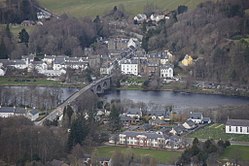Little Dunkeld
| Little Dunkeld | |
| Perthshire | |
|---|---|
 Dunkeld and Little Dunkeld from Birnam Hill | |
| Location | |
| Grid reference: | NO028423 |
| Location: | 56°33’46"N, 3°34’58"W |
| Data | |
| Post town: | Dunkeld |
| Postcode: | PH8 |
| Local Government | |
| Council: | Perth and Kinross |
Little Dunkeld is a village and parish standing on the west bank of the River Tay, in Perthshire, opposite Dunkeld.
The village began as no more than a cluster of houses around the bridgehead, but with a large parish attached to it, known in former days as "Dunkeld the Minor Charge", in contrast to "Dunkeld the Major Charge", which was the City of Dunkeld, on the eastern bank.
The Statistical Account of Scotland (1792) described the parish as:
"divided by nature into three districts, each of which would make a parish of ordinary magnitude, stretching from its eastern boundary at Kinclaven to the small village of Invar, then northward along the Tay to Grandtully and westward to Amulree, covering a tract of country containing 31,000 acres."
History
Bishop Brown (1484-1514) divided the Parish of Little Dunkeld (fully 16 miles across) in two to create the parish of Caputh, and it is recorded that he founded and endowed a church specifically to cater for the Gaelic-speaking population of the upland parts of the latter parish.
This was a lawless parish in former days, with cattle-raiders striking the farms of with apparent impunity. A poem in Scots laments:
"Oh what a parish, a terrible parish,
Oh what a parish is Little Dunkel’,
They hae hangit the minister, drouned the precentor,
Dung doon the steeple and drucken the bell.
Though the steeple was doon, the kirk was still staunin’,
They biggit a lum where the bell used tae hang,
A stell-pat they gat an’ they brewed Highland whisky,
On Sundays they drank it, an’ rantit an’ sang."